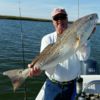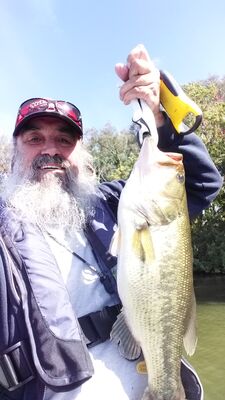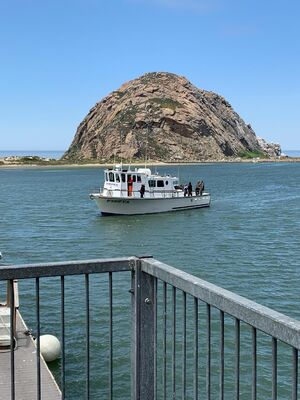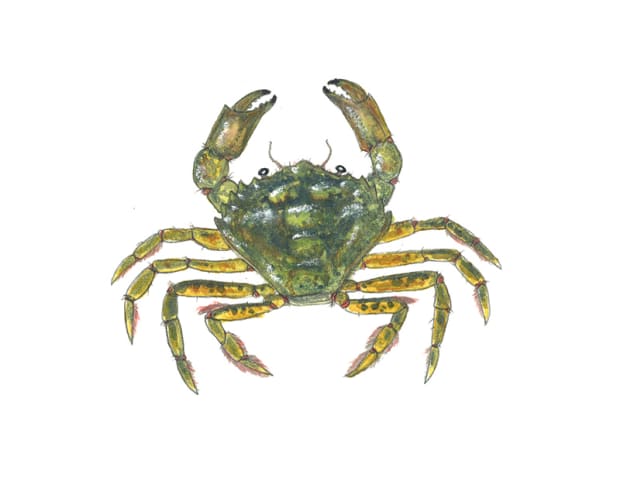Cult of the Tog
Jan 20, 2022 15:18:04 #
A story sent to me by Anglers Journal. Heard a few of Y'all from this area talk about these fish and wanted to share.
The beach town was deserted, abandoned months earlier by the bennies that overpopulate it during the summer. It was a raw morning in early January, the sun still an hour away from dragging itself over the horizon in a vain attempt to fight off winter.
The lone representative of the community’s off-season police force sat in a patrol car in front of the only place to get a cup of coffee at 5 a.m., and he watched as a ragtag group of men stumbled out of vintage SUVs and pickups. They grabbed their morning dose of caffeine, then drove off slowly down Bay Avenue in Ocean City, New Jersey, looking for a specific walkway between Second and Third streets.
Behind an old house with weather-streaked cedar shakes was an even older wooden party boat of dubious reputation that drew the early risers like metal filings to a magnet. The smell of rotting green crabs emanating from the dock would be enough to put off more genteel fishermen, but not these guys. This was a group on a mission, each member hoping to catch the fish of his dreams, a fish that more refined anglers might shudder to consider a gamefish. All were drawn here by the chance to nail a huge bottom-dwelling blackfish, or tautog, a hard-featured, no-nonsense fish with a devoted following.
What the party boat lacked in creature comforts and speed it more than made up for in reputation. The North Star is known by fishermen of a certain ilk as a lucky vessel, the one from which Anthony Monica caught a world-record tautog 18 years ago on a cold, windy January day in 6- to 8-foot winter seas. That 25-pounder remained the fish to beat until early this year, when a 28-pound, 13-ounce tautog was caught off Ocean City, Maryland, by another blackfish fanatic.
As the headboat pulled away from the dock, stories were swapped while heavy layers of clothing were donned and then encased under PVC bibs or stained, insulated Carhartt overalls. No Patagonia, L.L. Bean or Orvis for this bunch. Wool watch caps were pulled down over ears. Some guys sat quietly at tables tying rigs. A few sage members shared tantalizing glimpses of their exploits with the less experienced but equally enthusiastic newcomers to the Cult of the Tautog.
To be an inductee requires strict devotion to pursuing trophy-size blackfish while suffering the afflictions associated with being on the ocean in winter.
Beauty or Beast
The word tautog derives from tautauog, the name the Narragansett Indians gave to blackfish. Devotees further truncate the name, simply calling them tog.
Tautog are temperate-water members of the wrasse family and considerably larger than most of their kin, which tend to be tropical in locale, gaudy in color and rarely larger than 10 inches, with a few notable exceptions. It seems the farther north that wrasse species are found, the duller the coloration, which holds true for one of the tautog’s few Northern cousins, the cunner or bergall. The fish range from Nova Scotia to South Carolina, but they are most popular with anglers between Massachusetts and Virginia.
Tautog pull hard and have a devoted following.
Although outlanders might be hard-pressed to call the tautog handsome, the faithful see only beauty in those big heads, round teeth and tough, slimy skin. They also are great eating. Male tautog are dull in appearance, dark gray to black on the back and sides, with a white belly that extends forward to the jutting bottom jaw, a feature responsible for the nickname “white chin.”
The coloration of females varies from mottled shades of brown to a dull bronze-tinged brown, without the bright belly. The head is rounder and doesn’t have the prominent lower jaw. Both have heavily muscled bodies with wide, broom-like tail fins, the source of their brute force. They eat mollusks and crustaceans, which they pass back from a mouth adorned with rounded teeth to a set of crushers in the rear of the throat that look like a plate of tightly packed molars. There the tautog squash the shells of the critters before swallowing them; the remainder of the shells are passed after digestion.
The pursuit of trophy tautog is done from both private boats and those for-hire vessels that have earned a reputation for consistently producing large fish. Although record fish have been taken elsewhere, the monsters typically come from the waters between Ocean City, New Jersey, and Ocean City, Maryland, where the new world record came over the rail in January 2016.
Brawlers
Blackfish are a slow-growing fish, and latitude appears to have a direct effect on their growth rate. Though they can live 35 years or more, a 3-pound tog in Massachusetts might be 10 years old, but that same fish farther south might be as young as 6 due to warmer water and a longer growing season.
They migrate inshore to spawn along beaches and in bays and head back offshore in the fall, with the bottom temperature dictating how deep they push, though they are rarely found deeper than 160 feet. If the water is too cold, their metabolism slows and they become semidormant, with little feeding taking place. This is why the Southern contingent tends to grow faster and larger and can be caught throughout the winter. It’s also the reason there’s an influx of cultists to these waters at that time of year.
Tautog make their home in the nastiest hard-bottom structures imaginable. They sport a heavy coat of slime that allows them to slip easily along sharp edges and through tight confines without injury. The slime is responsible for another tautog nickname: slippery bass. Home can be rock outcroppings, mussel beds, reefs or any man-made detritus on the ocean floor. Wrecks are particularly tog-friendly — and the kind of place where it’s difficult to pry out a big one.
There’s nothing fancy or flashy about the way a tautog fights. They don’t jump; there are no visuals. They don’t make long, blistering runs capable of melting drag washers. They are just doggedly strong and can muster an incredibly determined sprint back to their hidey-holes against heavy line and a locked-down drag. Their popularity is a combination of their brawling fight and the challenge of deciphering bites and setting the hook.
The tackle used might seem overmatched for the fish, but until you’ve been on the end of a tug of war with a double-digit tog, you really have no idea. The power they generate with their massive tail fin is disproportionate to their physical size and inspires a healthy dose of respect among their followers. If allowed to regain the structure from which they came, the result is usually a severed line or leader, parted as if it were thread.
New Record
Early this year, longtime tog nut Kenneth Westerfeld caught a 28-pound, 13-ounce blackfish, which broke the 18-year-old record that Monica held. “What captured my imagination about tog was basically everything,” says Westerfeld, 50, of College Point, New York, who has fished the salt since he was a boy. “The feel of the bite was different than anything I’d fished for before. Learning when to set the hook is an art form. There are days when the action is blistering fast — no patience required, just instant gratification. Then there are those days when it’s slow and you have to deal with scratchy, almost imperceptible bites and hope to get the timing just right.”
In his pursuit of big tog, Westerfeld eventually heard about the fishing out of Ocean City, Maryland. He started booking charters with a small cadre of sharpies aboard Capt. Monty Hawkins’ Morning Star and Capt. Kane Bounds’ Fish Bound, both out of Ocean City. Westerfeld nailed a 12- and a 14-pounder on one of his early forays, and the trips south quickly became a regular commute.
“I love the fight,” says Westerfeld, who sharpened his skills under the tutelage of Capt. Edward Parker, who fished tog commercially with hook and line and often brought along a few sharpies, including Westerfeld, to help fill orders. “Pound for pound, the bulldogging is just unbeatable. The feeling I get when I hang a big one is indescribable.”
The feeling hit him hard on Jan. 2. Westerfeld was fishing in 140 feet of water on Fish Bound when the 28-plus-pound tog munched his crab and was hauled into the record books.
Diehards
I first bumped into Stelio Gatanas — “Stelly” to his fellow cult members — in January 2006 aboard the Mary M, an old wooden headboat. I was being dragged into the secret society by friend and fellow tautog aficionado Tim Surgent, owner and humble head tyrant of Stripersonline.com, which includes a bottom-fishing forum that’s used for communication between tribe members. The boat was in Cape May, New Jersey, that winter because the captain loved fishing for big tog; the rest of the year it was berthed in Barnegat Light.
Stelly Gatanas is a big guy with a perpetual 5 o’clock shadow and an intensity at the rail that he rarely interrupts with a smile, even when he nails a big one. “I still use monofilament,” says Gatanas, a foreman with the New Jersey Department of Transportation," which makes me a Neanderthal to a lot of other guys.”
At day’s end we were pitted against each other for the pool money. I presented what had to be the ugliest female tog ever boated. It had no lips, a misshapen mouth and a massive round body, my biggest to date. He offered up an impressive white-chin male that looked enormous. At the weigh-in he beat my 13.5 by 1 pound; he went home a few hundred dollars richer, and I pocketed a much smaller second-place purse.
Gatanas is from Woodbridge, New Jersey, and he’s the ultimate tog fanatic. “When I was a kid I fished with my uncle aboard Jersey headboats,” he says. “On the Jersey Devil out of Barnegat probably 30 years ago, he caught two 14-pound tog on one drop with a two-hook rig called a snafu. He hooked me that day, too.”
Years later Gatanas bought his own boat and fished out of Atlantic Highlands, New Jersey, but it was never enough. He started traveling, first to south Jersey, where I met him. With a loose-knit group of similarly afflicted anglers, he started trekking to Delaware, where he caught a tog weighing 19.5 pounds, and farther south to Maryland. He saves his vacation time and uses it from December through February, taking a few days off at a shot so he can make multiday runs to fish with the likes of captains Bounds and Hawkins.
Tog are not the prettiest fish in the sea, but their diehard fans love them nonetheless.
Funny thing: If it weren’t for tog fishing, Gatanas might still be single. “I met my future wife’s father on a tog trip down South and started bumping into him down there a lot,” the angler recalls. “Then I’d make it a point to hook up with him when I was going. After he got to know me, he introduced me to his daughter.”
They started dating, and Gatanas eventually proposed. “When we were setting a date I asked her if she wanted a spring or fall wedding,” he says. “She said fall. I said OK, but I told her there was a hitch. The wedding and honeymoon had to be over by Nov. 16 because that’s when tog season opens in New Jersey. A man has to have priorities, and she totally understood.”
One Big Fish
Among the small group of diehards that Gatanas stays in touch with is 50-year-old Alex Cortizo of Union, New Jersey, a blackfish devotee for more than 30 years. “I’ve been chasing that 20-pound tog for a long time and can see it hanging on the wall in my living room,” he says.
Cortizo has racked up 42 double-digit blackfish over the years, but like most hard-core sinker-bouncers, he is not yet in the 20-pound club. “Tog fishing is my sanctuary, and I get out as much as possible,” he says. “There aren’t a lot of boats that specialize in it, and our clique knows them all. Locally I ride the Fish Monger out of Point Pleasant, but come January I head south, looking for my 20. I would trade all the fish I’ve ever caught for that one.”
Capt. Bounds, the Ocean City, Maryland, skipper, carries a horde of tautog zealots each winter. “There’s this loose-knit group that comes to my boat to fish for them because the area has a reputation for producing really big fish,” says Bounds, who runs Fish Bound, the boat from which Westerfeld took his record fish. “About 50 percent come from New York and New Jersey, 30 percent from Virginia, and the rest from Pennsylvania and Connecticut. They meet on Internet forums or read about our fishing and then meet up on my boat or a few others that specialize.”
Bounds says he only sees the hard-core fishermen on winter tog trips. And as good as the fishing can be, catching really big tog is still hit or miss, he notes. “They don’t all grow that big, and it takes them a long time to get there,” he says. Some anglers will go away disappointed. “But not the really dedicated tog fishermen,” says the veteran captain. “They understand. The regulars are some of the most intense fishermen you’ll ever meet.”
And in case you’re wondering, I’ll be standing along the rail this winter, too.
The beach town was deserted, abandoned months earlier by the bennies that overpopulate it during the summer. It was a raw morning in early January, the sun still an hour away from dragging itself over the horizon in a vain attempt to fight off winter.
The lone representative of the community’s off-season police force sat in a patrol car in front of the only place to get a cup of coffee at 5 a.m., and he watched as a ragtag group of men stumbled out of vintage SUVs and pickups. They grabbed their morning dose of caffeine, then drove off slowly down Bay Avenue in Ocean City, New Jersey, looking for a specific walkway between Second and Third streets.
Behind an old house with weather-streaked cedar shakes was an even older wooden party boat of dubious reputation that drew the early risers like metal filings to a magnet. The smell of rotting green crabs emanating from the dock would be enough to put off more genteel fishermen, but not these guys. This was a group on a mission, each member hoping to catch the fish of his dreams, a fish that more refined anglers might shudder to consider a gamefish. All were drawn here by the chance to nail a huge bottom-dwelling blackfish, or tautog, a hard-featured, no-nonsense fish with a devoted following.
What the party boat lacked in creature comforts and speed it more than made up for in reputation. The North Star is known by fishermen of a certain ilk as a lucky vessel, the one from which Anthony Monica caught a world-record tautog 18 years ago on a cold, windy January day in 6- to 8-foot winter seas. That 25-pounder remained the fish to beat until early this year, when a 28-pound, 13-ounce tautog was caught off Ocean City, Maryland, by another blackfish fanatic.
As the headboat pulled away from the dock, stories were swapped while heavy layers of clothing were donned and then encased under PVC bibs or stained, insulated Carhartt overalls. No Patagonia, L.L. Bean or Orvis for this bunch. Wool watch caps were pulled down over ears. Some guys sat quietly at tables tying rigs. A few sage members shared tantalizing glimpses of their exploits with the less experienced but equally enthusiastic newcomers to the Cult of the Tautog.
To be an inductee requires strict devotion to pursuing trophy-size blackfish while suffering the afflictions associated with being on the ocean in winter.
Beauty or Beast
The word tautog derives from tautauog, the name the Narragansett Indians gave to blackfish. Devotees further truncate the name, simply calling them tog.
Tautog are temperate-water members of the wrasse family and considerably larger than most of their kin, which tend to be tropical in locale, gaudy in color and rarely larger than 10 inches, with a few notable exceptions. It seems the farther north that wrasse species are found, the duller the coloration, which holds true for one of the tautog’s few Northern cousins, the cunner or bergall. The fish range from Nova Scotia to South Carolina, but they are most popular with anglers between Massachusetts and Virginia.
Tautog pull hard and have a devoted following.
Although outlanders might be hard-pressed to call the tautog handsome, the faithful see only beauty in those big heads, round teeth and tough, slimy skin. They also are great eating. Male tautog are dull in appearance, dark gray to black on the back and sides, with a white belly that extends forward to the jutting bottom jaw, a feature responsible for the nickname “white chin.”
The coloration of females varies from mottled shades of brown to a dull bronze-tinged brown, without the bright belly. The head is rounder and doesn’t have the prominent lower jaw. Both have heavily muscled bodies with wide, broom-like tail fins, the source of their brute force. They eat mollusks and crustaceans, which they pass back from a mouth adorned with rounded teeth to a set of crushers in the rear of the throat that look like a plate of tightly packed molars. There the tautog squash the shells of the critters before swallowing them; the remainder of the shells are passed after digestion.
The pursuit of trophy tautog is done from both private boats and those for-hire vessels that have earned a reputation for consistently producing large fish. Although record fish have been taken elsewhere, the monsters typically come from the waters between Ocean City, New Jersey, and Ocean City, Maryland, where the new world record came over the rail in January 2016.
Brawlers
Blackfish are a slow-growing fish, and latitude appears to have a direct effect on their growth rate. Though they can live 35 years or more, a 3-pound tog in Massachusetts might be 10 years old, but that same fish farther south might be as young as 6 due to warmer water and a longer growing season.
They migrate inshore to spawn along beaches and in bays and head back offshore in the fall, with the bottom temperature dictating how deep they push, though they are rarely found deeper than 160 feet. If the water is too cold, their metabolism slows and they become semidormant, with little feeding taking place. This is why the Southern contingent tends to grow faster and larger and can be caught throughout the winter. It’s also the reason there’s an influx of cultists to these waters at that time of year.
Tautog make their home in the nastiest hard-bottom structures imaginable. They sport a heavy coat of slime that allows them to slip easily along sharp edges and through tight confines without injury. The slime is responsible for another tautog nickname: slippery bass. Home can be rock outcroppings, mussel beds, reefs or any man-made detritus on the ocean floor. Wrecks are particularly tog-friendly — and the kind of place where it’s difficult to pry out a big one.
There’s nothing fancy or flashy about the way a tautog fights. They don’t jump; there are no visuals. They don’t make long, blistering runs capable of melting drag washers. They are just doggedly strong and can muster an incredibly determined sprint back to their hidey-holes against heavy line and a locked-down drag. Their popularity is a combination of their brawling fight and the challenge of deciphering bites and setting the hook.
The tackle used might seem overmatched for the fish, but until you’ve been on the end of a tug of war with a double-digit tog, you really have no idea. The power they generate with their massive tail fin is disproportionate to their physical size and inspires a healthy dose of respect among their followers. If allowed to regain the structure from which they came, the result is usually a severed line or leader, parted as if it were thread.
New Record
Early this year, longtime tog nut Kenneth Westerfeld caught a 28-pound, 13-ounce blackfish, which broke the 18-year-old record that Monica held. “What captured my imagination about tog was basically everything,” says Westerfeld, 50, of College Point, New York, who has fished the salt since he was a boy. “The feel of the bite was different than anything I’d fished for before. Learning when to set the hook is an art form. There are days when the action is blistering fast — no patience required, just instant gratification. Then there are those days when it’s slow and you have to deal with scratchy, almost imperceptible bites and hope to get the timing just right.”
In his pursuit of big tog, Westerfeld eventually heard about the fishing out of Ocean City, Maryland. He started booking charters with a small cadre of sharpies aboard Capt. Monty Hawkins’ Morning Star and Capt. Kane Bounds’ Fish Bound, both out of Ocean City. Westerfeld nailed a 12- and a 14-pounder on one of his early forays, and the trips south quickly became a regular commute.
“I love the fight,” says Westerfeld, who sharpened his skills under the tutelage of Capt. Edward Parker, who fished tog commercially with hook and line and often brought along a few sharpies, including Westerfeld, to help fill orders. “Pound for pound, the bulldogging is just unbeatable. The feeling I get when I hang a big one is indescribable.”
The feeling hit him hard on Jan. 2. Westerfeld was fishing in 140 feet of water on Fish Bound when the 28-plus-pound tog munched his crab and was hauled into the record books.
Diehards
I first bumped into Stelio Gatanas — “Stelly” to his fellow cult members — in January 2006 aboard the Mary M, an old wooden headboat. I was being dragged into the secret society by friend and fellow tautog aficionado Tim Surgent, owner and humble head tyrant of Stripersonline.com, which includes a bottom-fishing forum that’s used for communication between tribe members. The boat was in Cape May, New Jersey, that winter because the captain loved fishing for big tog; the rest of the year it was berthed in Barnegat Light.
Stelly Gatanas is a big guy with a perpetual 5 o’clock shadow and an intensity at the rail that he rarely interrupts with a smile, even when he nails a big one. “I still use monofilament,” says Gatanas, a foreman with the New Jersey Department of Transportation," which makes me a Neanderthal to a lot of other guys.”
At day’s end we were pitted against each other for the pool money. I presented what had to be the ugliest female tog ever boated. It had no lips, a misshapen mouth and a massive round body, my biggest to date. He offered up an impressive white-chin male that looked enormous. At the weigh-in he beat my 13.5 by 1 pound; he went home a few hundred dollars richer, and I pocketed a much smaller second-place purse.
Gatanas is from Woodbridge, New Jersey, and he’s the ultimate tog fanatic. “When I was a kid I fished with my uncle aboard Jersey headboats,” he says. “On the Jersey Devil out of Barnegat probably 30 years ago, he caught two 14-pound tog on one drop with a two-hook rig called a snafu. He hooked me that day, too.”
Years later Gatanas bought his own boat and fished out of Atlantic Highlands, New Jersey, but it was never enough. He started traveling, first to south Jersey, where I met him. With a loose-knit group of similarly afflicted anglers, he started trekking to Delaware, where he caught a tog weighing 19.5 pounds, and farther south to Maryland. He saves his vacation time and uses it from December through February, taking a few days off at a shot so he can make multiday runs to fish with the likes of captains Bounds and Hawkins.
Tog are not the prettiest fish in the sea, but their diehard fans love them nonetheless.
Funny thing: If it weren’t for tog fishing, Gatanas might still be single. “I met my future wife’s father on a tog trip down South and started bumping into him down there a lot,” the angler recalls. “Then I’d make it a point to hook up with him when I was going. After he got to know me, he introduced me to his daughter.”
They started dating, and Gatanas eventually proposed. “When we were setting a date I asked her if she wanted a spring or fall wedding,” he says. “She said fall. I said OK, but I told her there was a hitch. The wedding and honeymoon had to be over by Nov. 16 because that’s when tog season opens in New Jersey. A man has to have priorities, and she totally understood.”
One Big Fish
Among the small group of diehards that Gatanas stays in touch with is 50-year-old Alex Cortizo of Union, New Jersey, a blackfish devotee for more than 30 years. “I’ve been chasing that 20-pound tog for a long time and can see it hanging on the wall in my living room,” he says.
Cortizo has racked up 42 double-digit blackfish over the years, but like most hard-core sinker-bouncers, he is not yet in the 20-pound club. “Tog fishing is my sanctuary, and I get out as much as possible,” he says. “There aren’t a lot of boats that specialize in it, and our clique knows them all. Locally I ride the Fish Monger out of Point Pleasant, but come January I head south, looking for my 20. I would trade all the fish I’ve ever caught for that one.”
Capt. Bounds, the Ocean City, Maryland, skipper, carries a horde of tautog zealots each winter. “There’s this loose-knit group that comes to my boat to fish for them because the area has a reputation for producing really big fish,” says Bounds, who runs Fish Bound, the boat from which Westerfeld took his record fish. “About 50 percent come from New York and New Jersey, 30 percent from Virginia, and the rest from Pennsylvania and Connecticut. They meet on Internet forums or read about our fishing and then meet up on my boat or a few others that specialize.”
Bounds says he only sees the hard-core fishermen on winter tog trips. And as good as the fishing can be, catching really big tog is still hit or miss, he notes. “They don’t all grow that big, and it takes them a long time to get there,” he says. Some anglers will go away disappointed. “But not the really dedicated tog fishermen,” says the veteran captain. “They understand. The regulars are some of the most intense fishermen you’ll ever meet.”
And in case you’re wondering, I’ll be standing along the rail this winter, too.
Jan 20, 2022 16:16:20 #
Well, Gordon, with a little work you could convert that essay to poetry. Just Sayin...RJS
Jan 20, 2022 17:06:13 #
Bob Browning
Loc: Cascade, Wisconsin
Very nice read, Gordon. I enjoyed it alot. Kinda felt like I was there. Thanks for the vacation. Lol
Jan 20, 2022 18:14:42 #
Gordon wrote:
A story sent to me by Anglers Journal. Heard a fe... (show quote)
Great post Gordon. I had Tog fever starting when I was a kid, all the way till I sold my Luhrs. They are wiley critters, awesome fighters, and one of the most delicious fish in the ocean.
I never hunted the monsters, but caught a few double digit fish over the years. I kinda miss the fall run, but the cold and I don't agree anymore. Thanks for the story G.

Jan 20, 2022 18:15:01 #
Awesome article Gordon! Now a double digit tog is on my bucket list.
Jan 20, 2022 18:27:27 #
Mauwehu
Loc: Norwalk Ct
Great story Gordon! The more I read the more intrigued I became. I’m hearing a sea chanty in my head…..dreaming of fishing in warmer weather. As Fred says “ I don’t do cold!”
Jan 20, 2022 18:27:44 #
Gordon wrote:
A story sent to me by Anglers Journal. Heard a fe... (show quote)
Yep hook line and sinker 🎣🎣🎣🎣👍🏽👍🏽👍🏽
Jan 20, 2022 18:44:00 #
Mauwehu wrote:
Great story Gordon! The more I read the more intrigued I became. I’m hearing a sea chanty in my head…..dreaming of fishing in warmer weather. As Fred says “ I don’t do cold!”
Hey Mau, you can try for a big springtime Tog. Get out to Two Tree Island, between Millstone and Harkness state park. That's where our state record fish was caught. 26lb 9oz.
Jan 21, 2022 00:15:58 #
Gordon wrote:
A story sent to me by Anglers Journal. Heard a fe... (show quote)
Well done Gordon, extraordinary good read. I’ve never fished for them but you’ve fueled that desire.
Jan 21, 2022 05:53:00 #
Great story Gordon, I now know what I may need to try if the opportunity presents itself. Thanks for sharing!
Jan 21, 2022 08:04:43 #
Good story Gordon ! What a way to meet your future Wife huh? A great way ! Thanks for sharing ,,,I read it twice, probably gonna read again ,,,
Jan 21, 2022 08:09:04 #
greenfrog
Loc: Central NJ
Good read Gordon. Thanks
Author of the story. Gary Caputi Updated: Jan 19, 2022 Original: Dec 22, 2020
https://www.anglersjournal.com/saltwater/cult-of-the-tog-tautog-fishing
Some pictures of the big tog from the article. They are bruisers.
Author of the story. Gary Caputi Updated: Jan 19, 2022 Original: Dec 22, 2020
https://www.anglersjournal.com/saltwater/cult-of-the-tog-tautog-fishing
Some pictures of the big tog from the article. They are bruisers.
Kenneth Westerfeld with his 28-pound, 13-ounce world record tog. Courtesy of Kenneth Westerfeld
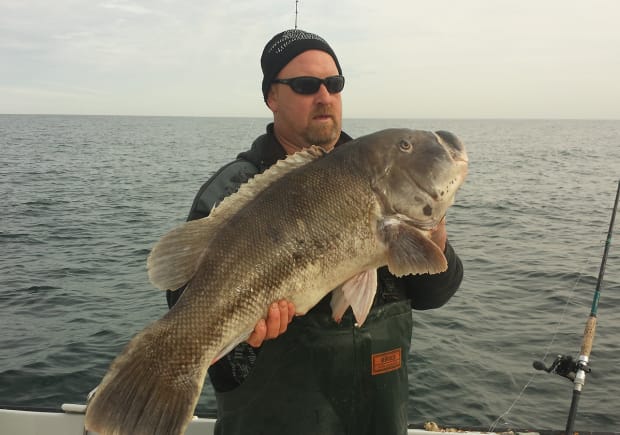
Stelly Gatanas with a 14.5-pound tog that won the day's pool money. Gary Caputi
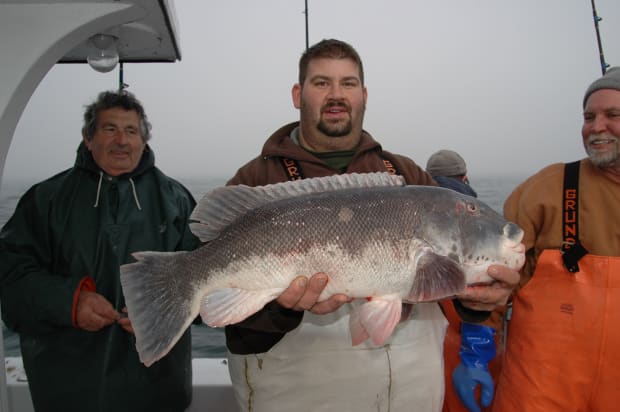
Jan 21, 2022 09:57:25 #
Great reading there Gordon Thank 👍🏽🎣🎣🎣🐟🐟🐠🐠🐋🐋🇺🇸🇺🇸🦅🦅
Jan 21, 2022 10:09:13 #
greenfrog wrote:
Good read Gordon. Thanks
Author of the story. Gary Caputi Updated: Jan 19, 2022 Original: Dec 22, 2020
https://www.anglersjournal.com/saltwater/cult-of-the-tog-tautog-fishing
Some pictures of the big tog from the article. They are bruisers.
Author of the story. Gary Caputi Updated: Jan 19, 2022 Original: Dec 22, 2020
https://www.anglersjournal.com/saltwater/cult-of-the-tog-tautog-fishing
Some pictures of the big tog from the article. They are bruisers.
Thanks Frog. I couldn't get the pictures to load. Can you post the green crab pic. They need to see the preferred bait.

Jan 21, 2022 10:29:31 #
If you want to reply, then register here. Registration is free and your account is created instantly, so you can post right away.
